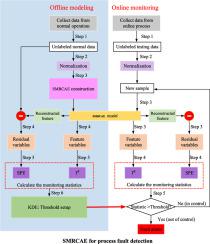Control Engineering Practice ( IF 5.4 ) Pub Date : 2021-04-10 , DOI: 10.1016/j.conengprac.2021.104811 Chengyi Zhang , Jianbo Yu , Lyujiangnan Ye

|
Deep neural networks (DNNs) are popular in process monitoring for its remarkable feature extraction from data. However, the increased dimension and correlation of the process variables degrade performance of these DNNs in feature extraction of data. This paper proposes a sparsity and manifold regularized convolutional auto-encoders (SMRCAE) for fault detection of complex multivariate processes. SMRCAE can learn high-level features from the data in an unsupervised way. A sparsity-and-manifold-regularization term is integrated into the learning procedure of SMRCAE, which allows SMRCAE to perform feature selection and capture intrinsic data information. Moreover, a depthwise separable convolution (dsConv) block is used to reduce the computational cost. Two typical fault detection statistics, namely Hotelling’s T-squared () and the squared prediction error (SPE), are developed on the feature space and residual space of SMRCAE, respectively. The performance of SMRCAE is evaluated on an industrial benchmark, i.e., Tennessee Eastman process (TEP) and a real process of industrial conveyor belts. The experimental results show the feasibility of SMRCAE in extracting representative features for process fault detection. The average fault detection rate of SMRCAE is 92.03% and 100% on the two cases, respectively.
中文翻译:

基于稀疏和流形正则化卷积自动编码器的特征学习用于多变量过程的故障检测
深度神经网络(DNN)由于其从数据中提取的卓越特征而在过程监控中很受欢迎。但是,过程变量的增加的维数和相关性会降低这些DNN在数据特征提取中的性能。本文提出了一种稀疏和流形正则化卷积自动编码器(SMRCAE),用于复杂多元过程的故障检测。SMRCAE可以无监督的方式从数据中学习高级功能。稀疏和流形正规化术语已集成到SMRCAE的学习过程中,这使SMRCAE可以执行特征选择并捕获固有数据信息。此外,使用深度可分离卷积(dsConv)块来减少计算成本。两种典型的故障检测统计数据,即Hotelling's T-平方()和平方预测误差(SPE),分别在SMRCAE的特征空间和残差空间上展开。SMRCAE的性能是根据工业基准进行评估的,即田纳西·伊士曼过程(TEP)和工业传送带的实际过程。实验结果表明,SMRCAE在提取代表性特征以进行过程故障检测中是可行的。两种情况下,SMRCAE的平均故障检测率分别为92.03%和100%。











































 京公网安备 11010802027423号
京公网安备 11010802027423号